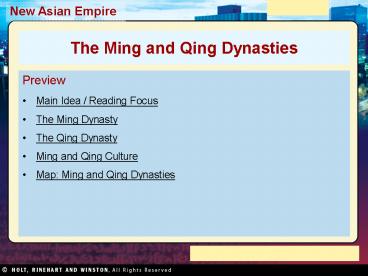Preview PowerPoint PPT Presentation
1 / 18
Title: Preview
1
The Ming and Qing Dynasties
- Preview
- Main Idea / Reading Focus
- The Ming Dynasty
- The Qing Dynasty
- Ming and Qing Culture
- Map Ming and Qing Dynasties
2
The Ming and Qing Dynasties
Main Idea During the Ming and Qing dynasties,
China prospered, but the empire entered a period
of isolation in response to increasing European
contact.
- Reading Focus
- How did the Ming dynasty bring stability,
prosperity and isolation to China? - How did the Manchus of the Qing dynasty rule
China? - What cultural developments occurred during the
Ming and Qing periods?
3
The Ming Dynasty
In 1279 the Mongol leader Kublai Khan conquered
China and founded the Yuan dynasty. After his
death in 1294, the Yuan dynasty weakened. This
weakness, combined with Chinese resentment of
Mongol rule, made China ripe for rebellionand
the rise of a new dynasty.
In addition, Hongwu worked to eliminate Mongol
influences and revive traditional Chinese values
and practices, like Confucian principles.
4
- Values, Traditions
- To obtain government officials educated in
Confucian ideas, Hongwu restored, improved civil
service examination system - To root out corruption, increased influence of
censors, officials who monitored government
- Expanded Power
- Hongwu also greatly expanded power as emperor
- Did away with positions of some high level
officials, took over more control of government - As result, Ming emperors more powerful than in
previous dynasties - Eliminated anyone challenging authority killed
thousands of rivals
5
Yonglo
- In 1398 Hongwu died
- Following power struggle, son Yonglo became
emperor - Ruled from 1402 until 1424
- Moved Ming capital to Beijing, in northeast China
- Built vast imperial city at center of Beijing
- City complex became known as Forbidden City
because most people forbidden from entering
6
Ming Sea Voyages
7
Ming Foreign Relations
The policy to end the voyages was part of a move
in Ming China toward isolation from the outside
world.
8
Outside Influences
- European Influence
- Some Europeans gained influence in China
- One was Matteo Ricci, Italian Jesuit priest
arrived 1583
- European Learning
- Ricci learned Chinese, adopted customs to gain
acceptance - Introduced European learning in math, science
- Mongol Threat
- Ming also faced renewed Mongol threat to north
- To improve defense, Ming restored Chinas Great
Wall
- Great Wall
- Parts of earlier walls repaired, but most
construction new - Much of Great Wall seen today built during Ming
period
9
(No Transcript)
10
Ming Economy and Society
- Prosperity
- Ming rule brought prosperity to China
- Improved methods of irrigation increased farm
production - Peasants produced huge rice crops in southern
river valleys
- Growth of Crops, Population
- 1500s, new crops like corn, sweet potatoes from
Americas reached China - These crops further increased farm output
- Stability, plentiful food led to substantial
population growth
- Growth of Cities, Industries
- As population grew, so did cities
- Industries like manufacture of porcelain, silk
expanded in response to growing European demand - At same time, China remained mainly agricultural
society
11
Ming Decline
12
Analyze What were some of the strengths and
weaknesses of the Ming dynasty?
Answer(s) strengthsincreased stability and
prosperity weaknessesisolation from foreign
influence, weak rulers in the late 1500s
13
The Qing Dynasty
The Qing Dynasty became the last dynasty in 3,500
years of imperial rule in China. Under the Qing
Dynastys Manchu rulers, China again grew
prosperous and expanded to its largest size in
history.
14
Qing China
Qing China flourished under two outstanding
emperors, Kangxi and his grandson Qianlong.
15
Qing Foreign Relations
- Qianlong continued Ming policy of isolation,
restricting foreign trade - Like Chinese, Manchu saw Chinese civilization,
products, as superior, expected foreigners to
trade on Chinas terms - Accepting terms, Dutch began thriving trade in
Chinese goods - Obtained Chinese porcelain, silk, along with
teawhich soon became main Chinese export to
Europe
16
Draw Conclusions How did cultural differences
hamper trade relations between the British and
the Chinese during the Qing period?
Answer(s) The British official who came to trade
did not perform a traditional gesture of respect
to the emperor, and was sent away.
17
Ming and Qing Culture
Under Ming and Qing rule, the Chinese made many
developments in the arts and literature.
18
Analyze How did literature change during the
Ming period?
Answer(s) Popular fiction was written in
everyday language short stories became popular.

